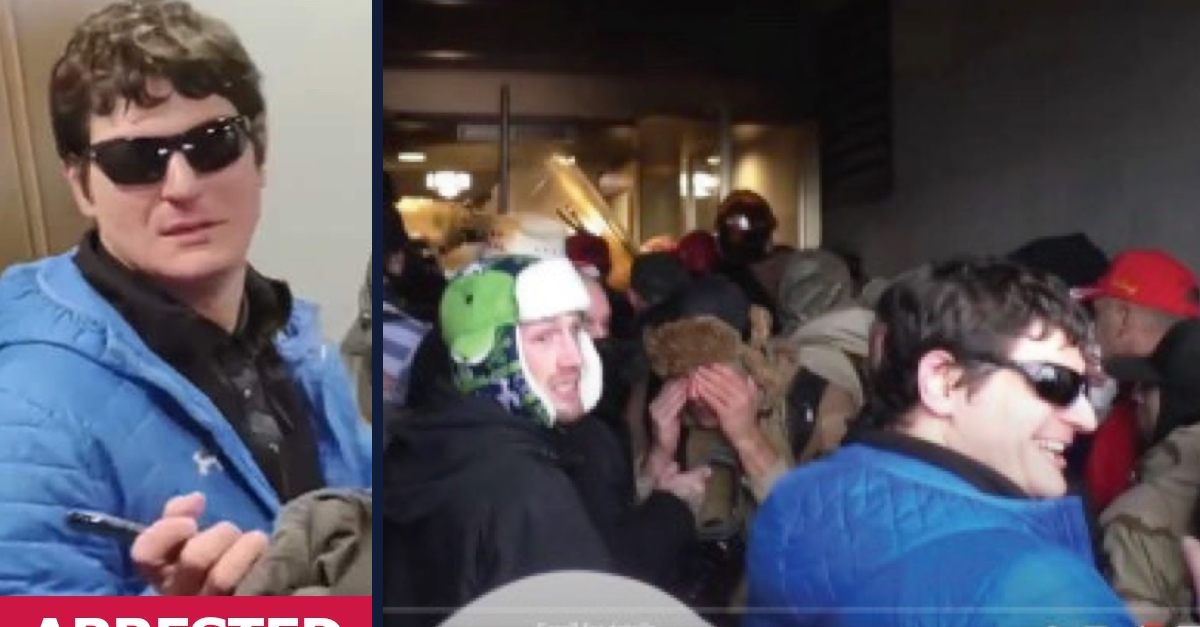
Vitali GossJankowski (images via FBI)
A Florida man who was seen “activating” a Taser multiple times while in the crowd battling law enforcement during the Jan. 6 attack at the U.S. Capitol has been convicted of assaulting law enforcement and trying to block an official proceeding of Congress.
Vitali GossJankowski, 34, was convicted on Thursday after a nine-day trial and one day of jury deliberation. According to prosecutors, GossJankowski — then attending a Washington, D.C., university for deaf and hard of hearing students — had joined the mob of angry Donald Trump supporters in the hourslong battle against police at the Lower West Terrace tunnel. He had gone to the Capitol after attending Trump’s speech at the so-called “Stop the Steal” rally near the White House, where the then-president encouraged his followers to “fight like hell” against the certification of Joe Biden’s 2020 electoral win.
While at the tunnel, GossJankowski watched and stood near other rioters as they used poles to strike a line of police officers trying to keep the crowd away from the building. He also watched rioters break a glass door that was clearly marked with the words “Members Entrance Only.” He was later seen on footage from surveillance cameras and officer body-worn cameras — as well as other rioters’ cellphone videos — pushing and spitting at police officers and pulling at their protective shields, according to the Justice Department. He also joined a concerted effort to push against the line of officers and urged other rioters to join the fight against law enforcement.
At one point, he was seen holding a “black-colored handheld Taser,” according to the Justice Department’s probable cause affidavit. He was also allegedly seen “activating the Taser multiple times, as evidenced by light flashes emanating from the Taser’s tip; and pushing himself through the crowd of violent individuals towards the police line that was protecting the entrance to the U.S. Capitol building,” federal investigators said.
He also apparently helped pass a clear ballistic shield away from the entrance to the Capitol building, prosecutors say.
According to the probable cause affidavit, GossJankowski voluntarily turned himself in to the Metropolitan Police Department seven days after the Capitol attack. At that time, GossJankowski — apparently wearing the same blue jacket he had worn on Jan. 6 — told investigators that he had found a Taser on the ground when he was walking toward the Capitol and had thrown it away in a trash can outside the building.
Prosecutors, however, indicate that GossJankowski may have tried to deploy the stun gun on a police officer. When two police officers were pulled into the crowd, GossJankowski “pushed his way through the crowd just outside the tunnel and grabbed an officer with the United States Capitol Police by his helmet,” the DOJ said in a press release.
“GossJankowski pulled the officer close and reached toward the officer with an unrecovered device GossJankowski would later call a taser,” the DOJ said. “The officer suffered no additional harm and would later be escorted out of the crowd where he then returned to the Capitol to continue battling rioters attempting to enter the building.”
Investigators say that during an interview 11 days after the attack, GossJankowski was shown a picture of Metropolitan Police Officer Michael Fanone, who was dragged into the crowd, assaulted, and Tased multiple times by a mob of rioters, suffering a minor heart attack and requiring hospitalization as a result.
GossJankowski “recognized Fanone in the snapshot and described him as the officer with tattoos on his neck,” the initial charging documents say. “He said he did not use his Taser on Officer Fanone, but if he touched him, he touched his helmet and it was merely to help him.”
GossJankowski also told investigators that he took pictures and video while on Capitol grounds, but that he “either deleted them or they were lost when his phone died.”
After one day of jury deliberation, GossJankowski was convicted of obstructing, impeding, or interfering with law enforcement during a civil disorder; obstruction of an official proceeding of Congress, and assaulting, resisting, opposing, impeding, or interfering with a law enforcement officer on account of his official duties. Those felonies carry a combined potential 33 years in prison.
GossJankowski was also convicted of three trespassing and disorderly conduct misdemeanors, which carry a combined maximum sentence of 30 months behind bars.
Despite having been seen carrying a Taser, GossJankowski was acquitted of using a deadly or dangerous weapon during the riot, which would have added a potential additional 40 years to any possible prison sentence.
U.S. District Judge Paul Friedman, a Bill Clinton appointee, did not set a sentencing date, according to the federal docket, leaving it to the parties to work together to determine a schedule for post-trial motions and sentencing. Friedman also allowed GossJankowski to stay out of jail pending sentencing on his own recognizance with additional conditions “to be imposed.”
At the time of the attack, GossJankowski was a student at Gallaudet University, a private university for deaf and hard-of-hearing students. At the time of GossJankowski’s arrest, school officials told the local news website Washingtonian that the school was conducting an internal investigation and cooperating with authorities.
The school “condemns violence and will not tolerate involvement by any student, employee, or vendor in violence,” a Gallaudet spokesperson told the Washingtonian. “Anyone engaged in violence will be subject to disciplinary action up to and including expulsion or termination.”
Have a tip we should know? [email protected]

